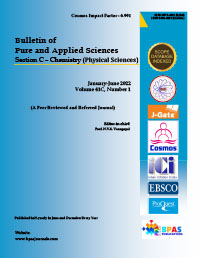Development of Al2014/Nano CarbonBlack Reinforced Aluminium Metal Matrix Composites
DOI:
https://doi.org/10.48165/bpas.2023.42C.2.4Keywords:
Nano-metal-matrix composites (NMCs), Aluminium alloys, XRDAbstract
Nano-metal-matrix composites (NMCs) are novel composite materials in which nano-phase such as nano-particles, nano-rods, nano-structured materials are reinforced with metals or alloys to improve the physical, mechanical, wear and other properties. The results of previous works have shown that the addition of nanoclay reinforcement to aluminium alloys has improved the hardness, tensile strength and Young’s modulus. Hence, the present work is focused on development and characterisation of nanoclay reinforced NMCs. Evaluating the effect of the reinforcement on the important physical properties such as corrosion properties studies were carried out. The recorded results from all tests were discussed in detail with supporting evidences. Optical microstructures confirmed the incorporation of Carbon black in Al matrix. Grain size measurement was done by two phase linear analysis method and the SEM, optical microscopy and XRD were used to observe the microstructure for CB dispersion and the particulate distribution in the composites. It was observed that the distribution of CB particles in the matrix was even without any visible accumulation. It was noticed that there was an increase in density of the MMCs with the increase in the weight percentage of the reinforcement. The corrosion by weight loss of the composite decreased with increase in the weight percentage of the reinforcement. The conclusions drawn indicatethe important results and outcome of the work.
Downloads
References
S. Suresha, B.K. Sridhara, (2011). Wear characteristics of hybrid aluminium matrix composites reinforced with graphite and silicon carbide particulates, Compos. Sci. Technol. 70, 1652–1659.
V. Hariharan, et al., (2014). A Review on Tribological and Mechanical Behaviours of Aluminium Metal Matrix Composites. Int. J. Mechanical Eng. Robotics. Vol. 2.
S. Cem, OKUMUS et al., (2012). Thermal Expansion and Thermal Conductivity
Behaviours of Al-Si/SiC/graphite Hybrid Metal Matrix Composites (MMCs). J. Mater. Sci. Vol. 18.
S. Jeyabala Krishnan, et al., (2007). Temperature Distribution Analysis of Friction Stir Welding of Al-Sic-Gr Hybrid Composites, Int. J. Innovative Res. Sci. Eng. Technol. An ISO 3297: 2007, Volume 4.
Keneth Kanayo et al., (2013). Fabrication characteristics and mechanical behaviour of rice husk ash – Alumina reinforced Al-Mg-Si alloy matrix hybrid composites, J. Mater. Res. Technol. (2013).
Vinayak Janiwarad, et al., (2013). The Effect of Heat treatment on Microstructure, Mechanical properties and Damping behaviour of hybrid composite of A356.0. Int. J. Innovative
Res. Sci. Eng. Technol. 2, 2013.
N. Adnan et al., (2013). Effect of Heat Treatment on Strain Life of Aluminium Alloy AA 606, J. Mater. Sci. Res. (2013), ISSN 2 1927–0585.
M. Wu, X.H. Qu, X.B. He, et al., (2010). Interfacial reactions between Sn-2.5Ag 2.0Ni solder and electroless Ni(P) on SiCp/Al composites, Trans Nonferrous Met Soc China 20 (6), 958–965.
D. Mishra Suresh et al., (2011). Production and Characterization of Micro and Nano Al2 O3 Particle Reinforced LM25 Aluminum Alloy, Composites, ARPN J. Eng. Appl. Sci. Vol. 6.
E. McCafferty, (1988). Effect of electrolyte volume on the acid dissolution of Al alloy 7075 Corrosion, 54(11), 862.
